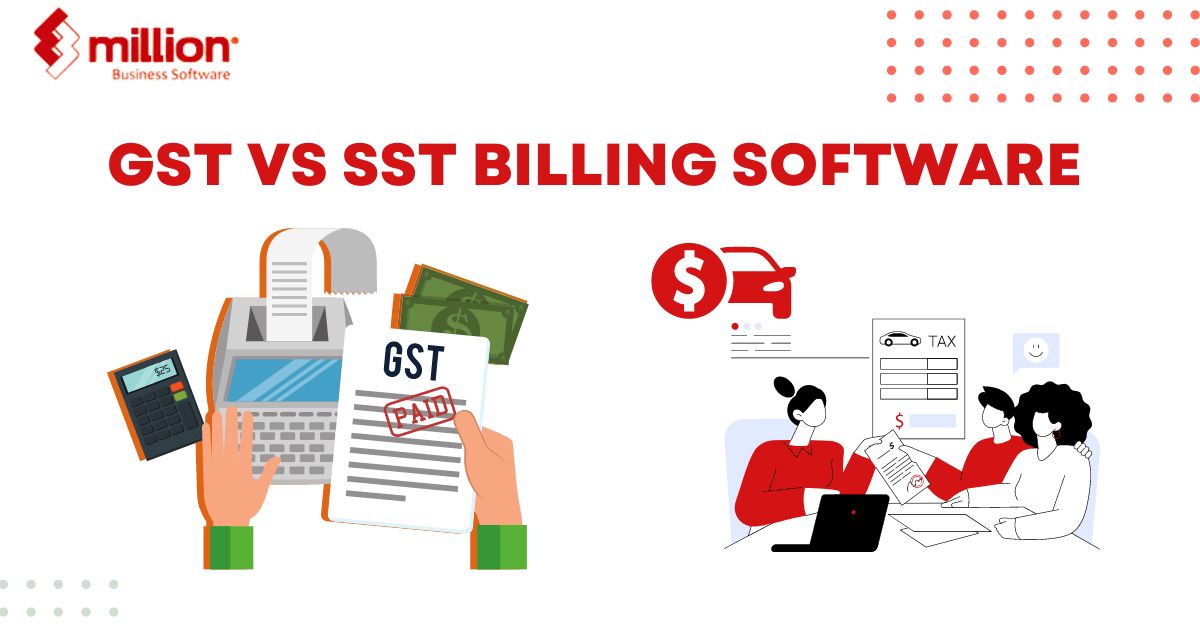
Introduction:
In the realm of taxation in Malaysia, two distinct systems have played a significant role in shaping the financial landscape for businesses—Goods and Services Tax (GST) and Sales and Services Tax (SST). The billing system adopted by a business has far-reaching implications on compliance, financial management, and overall operational efficiency. In this blog post, we’ll explore the differences between SST Vs GST billing systems, shedding light on their respective features, advantages, and considerations for businesses navigating the Malaysian tax landscape.
Understanding SST Vs GST:

1. Goods and Services Tax (GST):
– Introduced in 2015, GST was a value-added tax system that applied to the supply of goods and services at each stage of the supply chain. It replaced the previous Sales Tax and Service Tax systems.
2. Sales and Services Tax (SST):
– SST, on the other hand, represents a more traditional tax system. It is a consumption tax imposed on specific goods and services at various stages of the supply chain.
SST Vs GST: Differences in Billing Systems:
1. Taxable Goods and Services:
– GST was a comprehensive tax system, applying to a wide range of goods and services. SST, in contrast, is more selective in its taxation, focusing on specific goods and services.
2. Tax Calculation Method:
– GST operates on a value-added tax model, where taxes are applied at each stage of production or distribution. SST, however, is typically a single-stage tax applied at the manufacturing or importation stage.
3. Invoicing and Documentation:
– GST required businesses to issue tax invoices for all taxable supplies. SST, while also requiring proper documentation, follows a simpler invoicing system.
4. Tax Rates:
– GST had a standard rate of 6% on most goods and services. SST employs different rates for different categories of goods and services, with varying percentages.
SST Vs GST: Which One to Choose?
The choice between SST Vs GST in Malaysia depends on various factors, and there isn’t a one-size-fits-all answer. Each tax system has its own advantages and considerations. Here’s a brief comparison to help you understand the differences:
SST (Sales and Services Tax):
- Selective Taxation:
– SST is more selective in its taxation approach, focusing on specific goods and services. This can be advantageous for businesses dealing with products or services that fall within the SST framework.
- Single-Stage Tax:
– SST typically operates as a single-stage tax applied at either the manufacturing or importation stage. This simplifies the tax calculation process compared to the multi-stage approach of GST.
- Variable Tax Rates:
– SST applies different tax rates to different categories of goods and services, ranging from 5% to 10%. This variability allows for a more nuanced taxation approach.
GST (Goods and Services Tax):
- Comprehensive Taxation:
– GST is a comprehensive tax system that applies a standard tax rate (e.g., 6%) to a wide range of goods and services at each stage of the supply chain. This can be advantageous for businesses dealing with diverse products and services.
- Value-Added Tax Model:
– GST operates on a value-added tax model, where taxes are applied at each stage of production or distribution. This can provide more transparency in tracking the flow of taxes through the supply chain.
- Uniform Tax Rate:
– Unlike SST, GST maintains a uniform tax rate for most goods and services. This simplicity in the tax rate can make it easier for businesses to calculate and comply with tax obligations.
Choosing between SST Vs GST billing system involves considering factors such as the nature of your business, the types of goods or services you deal with, and the administrative burden associated with each system. Additionally, understanding the specific tax rates and compliance requirements under each system is crucial.
Final Thoughts:
It’s worth noting that Malaysia transitioned from GST to SST in 2018, and as of my last knowledge update in January 2022, SST is the prevailing tax system in the country. Businesses should stay informed about any changes in tax policies and assess their specific needs to make an informed decision based on the current tax landscape. Consulting with tax professionals or authorities can also provide valuable insights tailored to your business context.







